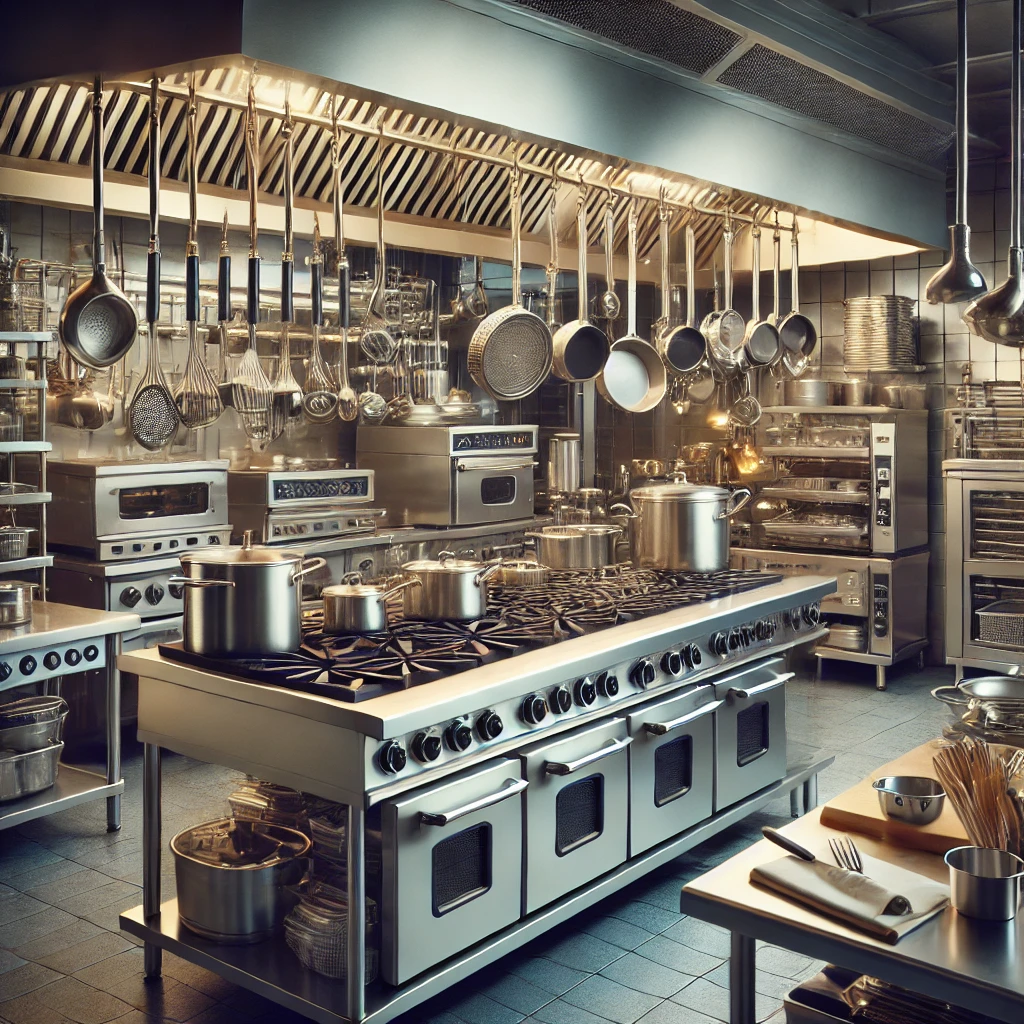A well-equipped commercial kitchen is essential for running an efficient restaurant, catering business, or food service operation. The specific equipment you'll need can vary based on the type of cuisine and the volume of customers, but there are certain essential items that every commercial kitchen should have. Here’s a breakdown of the key equipment to consider "under the hood" in a commercial kitchen:
1. Cooking Equipment
These are the backbone of any commercial kitchen and include:
-
Range/Stove: A commercial-grade stove with multiple burners (usually 4-10 burners) is essential for cooking multiple dishes simultaneously.
-
Oven: Depending on your needs, you might require a standard oven, convection oven, or specialized ovens like pizza ovens.
-
Grill/Griddle: For grilling meats, vegetables, and other items, a grill or griddle (charbroiler) is necessary.
-
Fryers: Deep fryers for items like fries, chicken, or fish are crucial in many kitchens. A double fryer may be useful if you need to cook multiple items simultaneously.
-
Steamers: Ideal for preparing vegetables or large quantities of food without losing nutrients.
-
Combi Ovens: These versatile ovens allow you to steam, roast, bake, or grill food in a single unit.
2. Refrigeration and Storage
Maintaining proper storage is essential to ensure food safety and operational efficiency:
-
Walk-in Coolers and Freezers: For bulk storage of perishables, walk-in units provide easy access and plenty of storage space.
-
Reach-in Refrigerators/Freezers: These units are used to store ingredients that need to be kept cool but are frequently used, ensuring they are easily accessible.
-
Undercounter Refrigerators/Freezers: These are space-saving units often installed under countertops to store commonly used ingredients near prep stations.
-
Prep Tables with Refrigeration: Used for assembling dishes, these prep tables often include built-in refrigeration to keep ingredients fresh.
3. Food Prep Equipment
To efficiently prepare food, the following tools are crucial:
-
Commercial Mixers: For bakeries, pizzerias, or other kitchens that make doughs and batters, a heavy-duty mixer is necessary.
-
Food Processors: Used for chopping, slicing, grating, or pureeing ingredients quickly and efficiently.
-
Blenders/Immersion Blenders: Useful for making sauces, soups, and drinks, commercial-grade blenders are a versatile tool in any kitchen.
-
Meat Slicers: If you work with large quantities of meat or need uniform slices, a high-quality meat slicer is essential.
4. Dishwashing Equipment
Maintaining cleanliness in a busy kitchen is critical for health and safety:
-
Commercial Dishwashers: These are designed to clean large quantities of dishes quickly and effectively. High-temperature models are preferred for sanitizing.
-
Three-Compartment Sinks: Used for washing, rinsing, and sanitizing cookware and utensils.
-
Grease Traps: Essential for preventing grease from clogging pipes and maintaining compliance with health regulations.
5. Ventilation and Safety
To maintain a safe working environment, you’ll need proper ventilation and safety equipment:
-
Commercial Range Hoods: A ventilation system is vital for removing smoke, steam, and grease-laden air from the kitchen to comply with health codes and create a safe work environment.
-
Fire Suppression Systems: Most hoods should include an integrated fire suppression system to quickly extinguish fires and meet safety regulations.
-
First Aid Kits: Readily available and well-stocked first aid kits are crucial for treating minor injuries.
6. Smallwares and Utensils
These are the tools that kitchen staff will use daily, and they include:
-
Knives and Knife Sets: High-quality chef knives, paring knives, and bread knives are essential for food preparation.
-
Cutting Boards: Typically color-coded to prevent cross-contamination (e.g., separate boards for meat, vegetables, etc.).
-
Pots, Pans, and Skillets: Different sizes of pots, pans, and skillets for frying, boiling, and sautéing.
-
Mixing Bowls: Stainless steel or glass bowls in various sizes for food prep.
7. Beverage Equipment
If your kitchen serves drinks or desserts, you'll need beverage equipment such as:
-
Coffee Makers: For restaurants, cafés, or catering businesses, commercial coffee machines are a must.
-
Juicers: If fresh juice is on the menu, you’ll need a high-capacity juicer.
-
Ice Machines: Ice machines are crucial for serving cold drinks, preserving seafood, or making blended beverages.
8. Storage and Shelving
For dry ingredients, utensils, and smallwares:
-
Dry Storage Shelving: Used to store non-perishable goods, dry ingredients, and cleaning supplies.
-
Racks and Speed Racks: For cooling baked goods, holding trays, or storing items that need to be easily accessible.
-
Ingredient Bins: Large bins to store bulk ingredients like flour, sugar, and grains.
9. Specialty Equipment (If Applicable)
Depending on your menu or specific culinary requirements, you may also need:
-
Sous Vide Machines: Used for slow-cooking food in water baths at precise temperatures.
-
Pizza Ovens: For pizzerias, a specialized pizza oven (brick, stone, or conveyor) is required.
-
Vacuum Sealers: Ideal for portioning food and extending shelf life by vacuum sealing ingredients.
10. Point of Sale (POS) System
Even though it’s not physically under the hood, a POS system is essential for order management, inventory tracking, and streamlining kitchen operations. Integrated POS systems help improve communication between the kitchen and the front-of-house team.
Conclusion
When setting up a commercial kitchen, it’s important to invest in high-quality, durable equipment to ensure your kitchen runs smoothly and complies with local health and safety standards. Each piece of equipment serves a specific purpose, from food prep and storage to cooking and sanitation. Be sure to assess your kitchen’s specific needs and select equipment accordingly, balancing function, quality, and cost.

